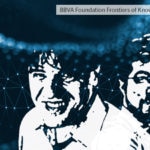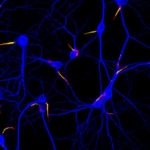Light to illuminate the living brain
Optogenetics is a technique whereby light serves to control the behavior of a live animal. The scene might go something like this: the laboratory rat sits peacefully in its box, but with a fiber optic cable emerging from its head. A light comes on and the animal starts to run; the light goes off, and it stops.

The clue to the importance of this experiment is that the optic fiber is delivering light to the brain region that controls movement, where its action is confined to specific neurons. The same strategy can be applied to memory, fear, addiction, depression, epilepsy, Parkinson’s disease… Optogenetics in its current form has been around for barely a decade, but it is already being employed in thousands of laboratories.
And more than one neuroscientist has marveled at a technique they describe as exactly what the field was crying out for. Optogenetics brings an unprecedented precision to bear on the study of the living brain. It ushers in the real possibility of determining which neural circuits are involved in which kind of behavior, and the promise of a meaningful improvement in our treatment of mental illness. Researchers are saying that optogenetics not only encourages them to be more ambitious, but evento think differently about the brain.

Edward S. Boyden III (Justin Knight/MIT), Karl Deisseroth (Saul Bromberger – Sandra Hoover, Stanford Engineering) and Gero Miesenböc (Greg Smolonski).
Neuroscientists Edward Boyden, Karl Deisseroth and Gero Miesenböck, the creators of optogenetics, sharethe BBVA Foundation Frontiers of Knowledge Award in Biomedicine. The story of their endeavors to develop optogenetics contains some surprising twists. For instance, how could something so warmly received by the research community initially meet with rejection from funding agencies and reviewers? Or, how did areas as disparate as the study of microorganisms insaline lakes, the physics of light and genomics end up cross fertilizing to arrive at a technique to explore brain function?
For the first time we can tease apart how specific kinds of brain cells can initiate something as complex as a behavior — Boyden
The imperative was to find the right neurotechnology. Francis Crick, one of the discoverers of the DNA structure, said many years ago that only a tool enabling control of specific neurons, in their natural – millisecond– firing time, could explain how a biological structure gives rise to the personality, imagination, suffering or curiosity. Crick wrote: “… the ideal signal would be light […]. This seems rather far-fetched, but it is conceivable that molecular biologists could engineer a particular cell type to be sensitive to light.”
The first finding in the genealogy of optogenetics dates from the early 1970s, when a German biochemist examining bacteria in saline lakes discovered a protein capable of turning light into electricity in a single biochemical step. What he had found was an opsin, a family of light-sensitive proteins also present in the human retina, although mammal opsins do not generate electricity so directly but by triggering a cascade of secondary molecules.

Neurons. The Journal of Cell Biology (Creative Commons)
To design specific therapies for somethingas mysterious as mental illness, you need a deep understanding of the brain — Deisseroth
The next chapter in the story brings opsins together with neuroscience. At the end of the 1990s, Gero Miesenböck (Braunau, Austria, 1965), now a professor at the University of Oxford (United Kingdom), set out to visualize neuronal activity using light-sensitive proteins. One Saturday afternoon the thought came to him: “Wouldn’t it be amazing to be able to control the brain’s activity as well as read it?” In 2002 Miesenböck showed that it was in fact possible to modulate neurons with light. He began with cultured cells rather than in vivo, but realized immediately that “this was a technology with immense transformative power.”
Miesenböck had managed to introduce microbial opsin genes into the DNA of brain cells. Thus illuminated, the cells responded like the salt lake bacteria before them, firing an electrical signal. Miesenböck’s technique, however, had technical drawbacks that hindered its large-scale use.
Americans Karl Deisseroth (Boston, 1971) and Edward S. Boyden (Plano, Texas, 1979) would deliver the solution. Deisseroth is now a professor at Stanford University, while Boyden is a research fellow at Massachusetts Institute of Technology (MIT). In 2004 the two men were together at Stanford, and had spent years attempting to fulfill Crick’s prediction.
They heard about a new type of opsin isolated the year before in a species of green alga, and decided to try it. The task was formidable: the opsin genes might be underexpressed in the neurons; the light might not reach the exact point in the brain… Only their motivation kept them going, and the fact that the U.S. National Institutes of Health operate a dedicated program for high-risk ideas.
Their boldness had its reward. The first proof of concept, with a single rat’s cell, went better than Deisseroth and Boyden dared expect, but the journals Science and Nature turned down the resulting paper, doubtful that the technique could ever be applied to living beings. A decade later, the feeling is that optogenetics has only just begun to show its power. The laureates all stress that its usefulness is primarily in basic research: optogenetics serves, first and foremost, to study the brain. Miesenböck is using it to investigate sleep and decision-making. Boyden is working to refine the technical side. And Deisseroth, a psychiatrist as well as a neuroscientist, hopes it will eventually help relieve the suffering associated with mental illness.
In order to understand a biological system, it is absolutely essential to be able to control it, something hitherto impossible in neuroscience — Miesenböck
Their boldness had its reward. The first proof of concept, with a single rat’s cell, went better than Deisseroth and Boyden dared expect, but the journals Science and Nature turned down the resulting paper, doubtful that the technique could ever be applied to living beings.
A decade later, the feeling is that optogenetics has only just begun to show its power. The laureates all stress that its usefulness is primarily in basic research: optogenetics serves, first and foremost, to study the brain. Miesenböck is using it to investigate sleep and decision-making. Boyden is working to refine the technical side. And Deisseroth, a psychiatrist as well as a neuroscientist, hopes it will eventually help relieve the suffering associated with mental illness.